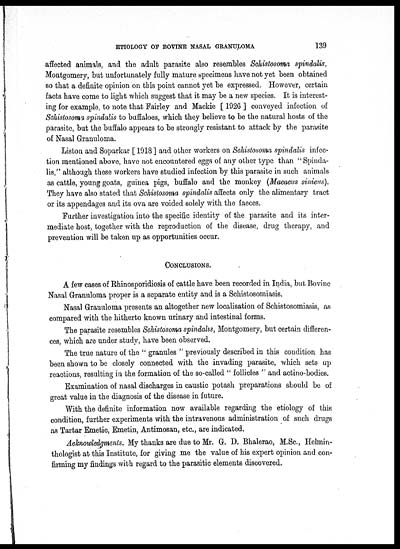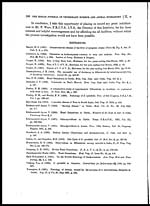Medicine - Veterinary > Veterinary colleges and laboratories > Indian journal of veterinary science and animal husbandry > Volume 2, 1932 > Original articles > Etiology of bovine nasal granuloma
(165) Page 139
Download files
Individual page:
Thumbnail gallery: Grid view | List view

ETIOLOGY OF BOVINE NASAL GRANULOMA 139
affected animals, and the adult parasite also resembles Schistosoma spindalis,
Montgomery, but unfortunately fully mature specimens have not yet been obtained
so that a definite opinion on this point cannot yet be expressed. However, certain
facts have come to light which suggest that it may be a new species. It is interest-
ing for example, to note that Fairley and Mackie [ 1926 ] conveyed infection of
Schistosoma spindalis to buffaloes, which they believe to be the natural hosts of the
parasite, but the buffalo appears to be strongly resistant to attack by the parasite
of Nasal Granuloma.
Liston and Soparkar [1918] and other workers on Schistosoma spindalis infec-
tion mentioned above, have not encountered eggs of any other type than " Spinda-
lis,'' although these workers have studied infection by this parasite in such animals
as cattle, young goats, guinea pigs, buffalo and the monkey ( Macacus sinicus) .
They have also stated that Schistosoma spindalis affects only the alimentary tract
or its appendages and its ova are voided solely with the faeces.
Further investigation into the specific identity of the parasite and its inter-
mediate host, together with the reproduction of the disease, drug therapy, and
prevention will be taken up as opportunities occur.
CONCLUSIONS.
A few cases of Rhinosporidiosis of cattle have been recorded in India, but Bovine
Nasal Granuloma proper is a separate entity and is a Schistosomiasis.
Nasal Granuloma presents an altogether new localisation of Schistosomiasis, as
compared with the hitherto known urinary and intestinal forms.
The parasite resembles Schistosoma spindalis, Montgomery, but certain differen-
ces, which are under study, have been observed.
The true nature of the " granules " previously described in this condition has
been shown to be closely connected with the invading parasite, which sets up
reactions, resulting in the formation of the so-called " follicles " and actino-bodies.
Examination of nasal discharges in caustic potash preparations should be of
great value in the diagnosis of the disease in future.
With the definite information now available regarding the etiology of this
condition, further experiments with the intravenous administration of such drugs
as Tartar Emetic, Emetin, Antimosan, etc., are indicated.
Acknowledgments. My thanks are due to Mr. G. D. Bhalerao, M.Sc., Helmin-
thologist at this Institute, for giving me the value of his expert opinion and con-
firming my findings with regard to the parasitic elements discovered.
Set display mode to: Large image | Zoom image | Transcription
Images and transcriptions on this page, including medium image downloads, may be used under the Creative Commons Attribution 4.0 International Licence unless otherwise stated. ![]()
| Permanent URL | https://digital.nls.uk/75227694 |
|---|
| Description | Covers articles from 1932. |
|---|




